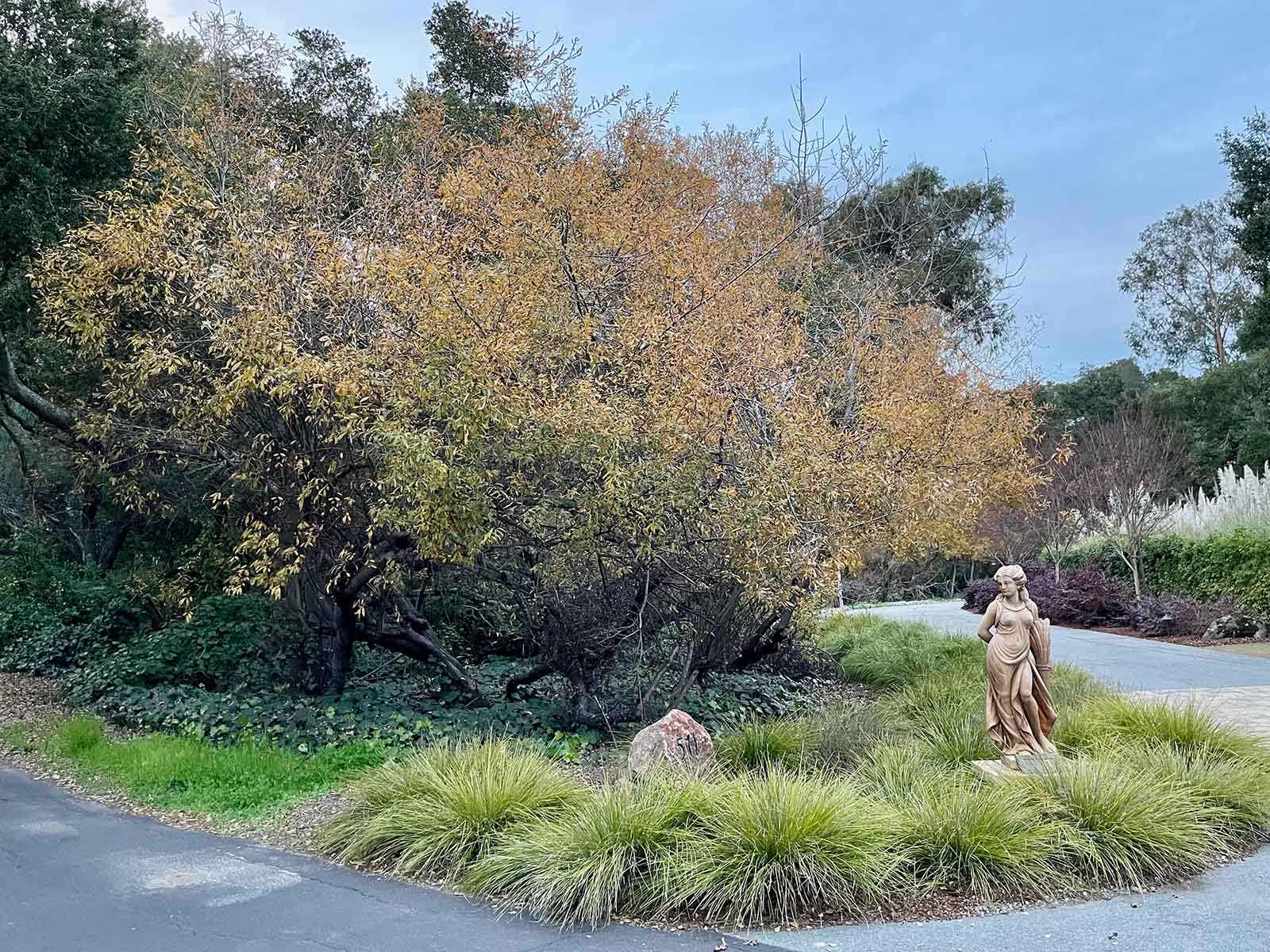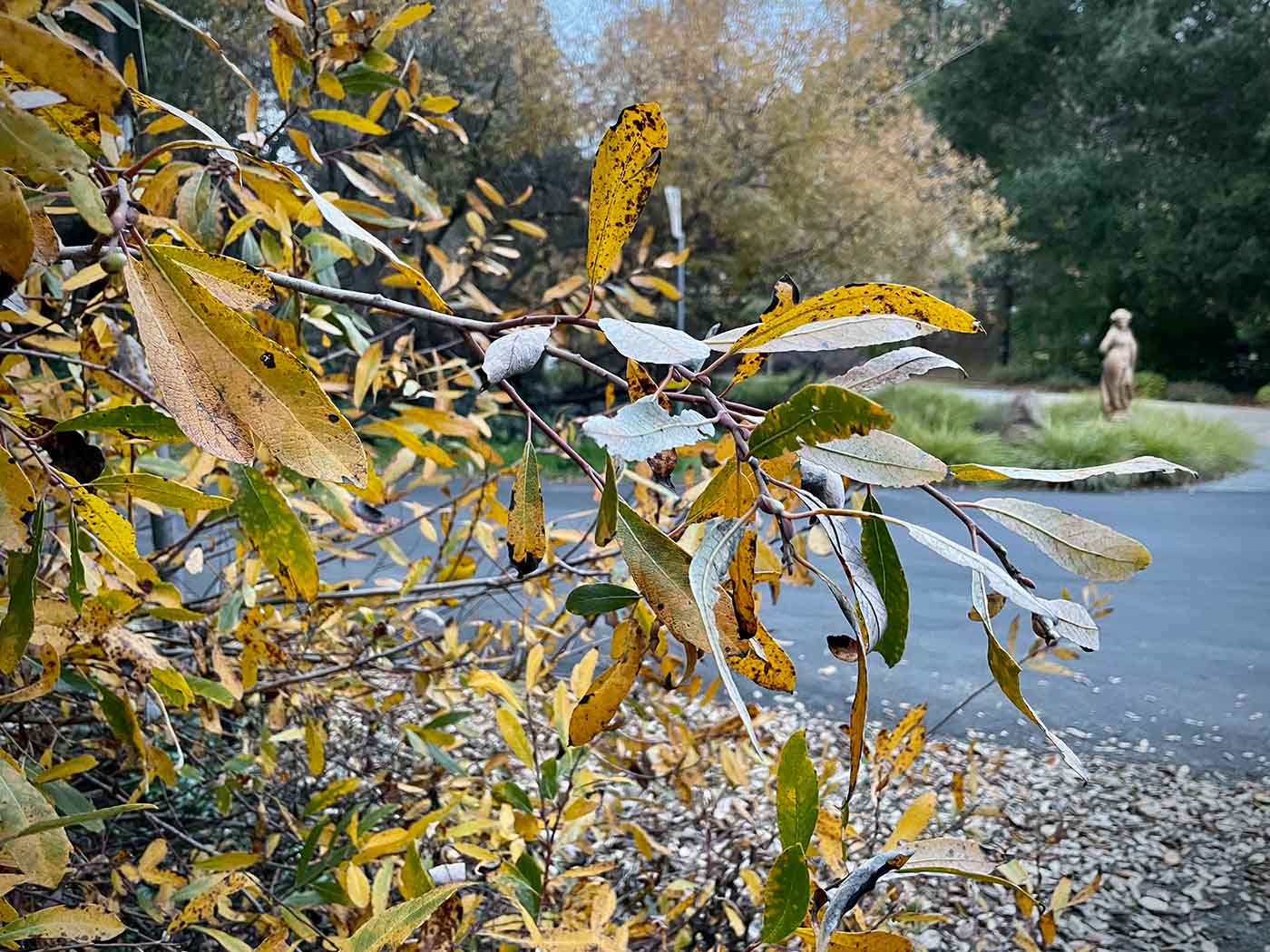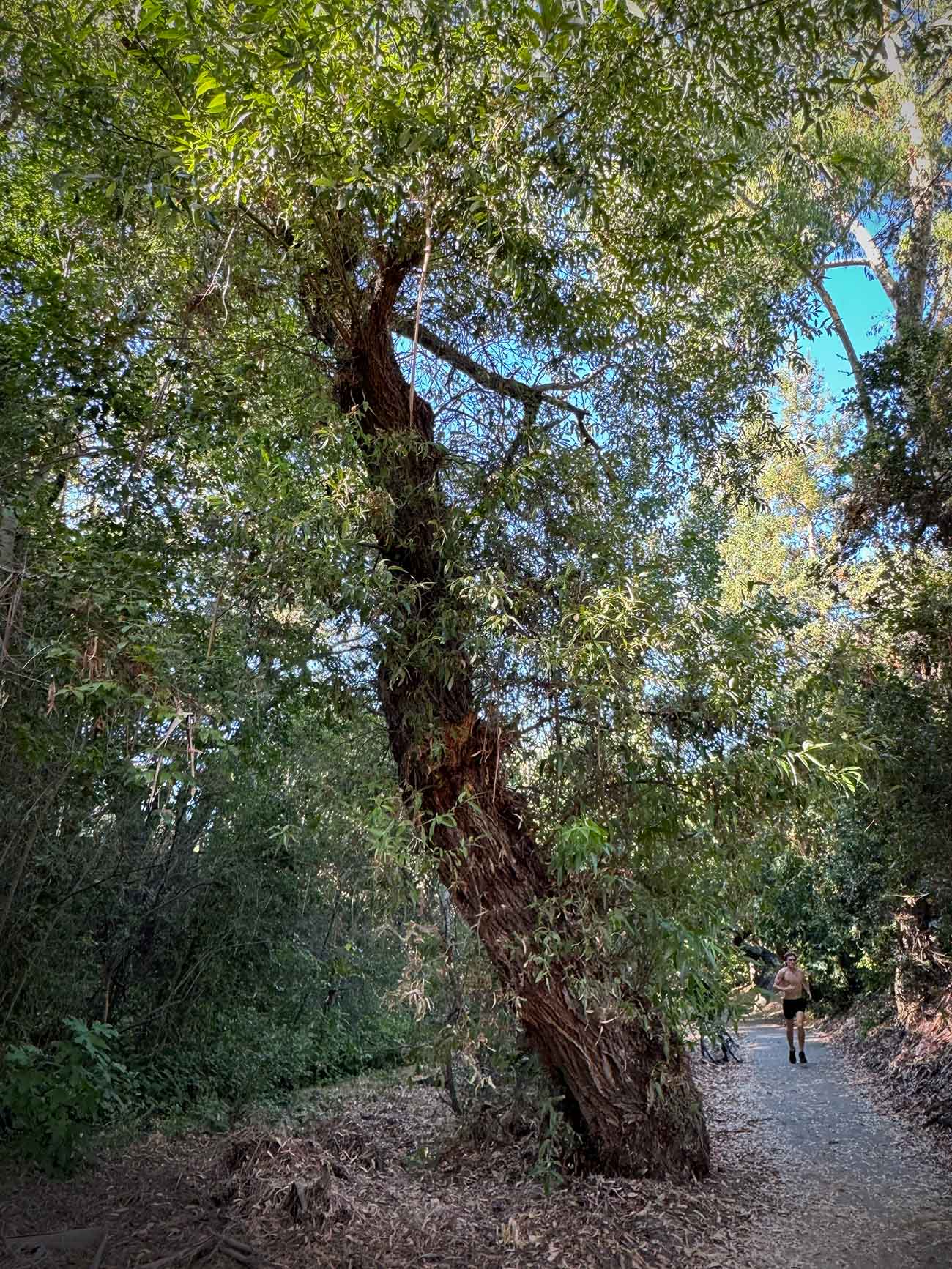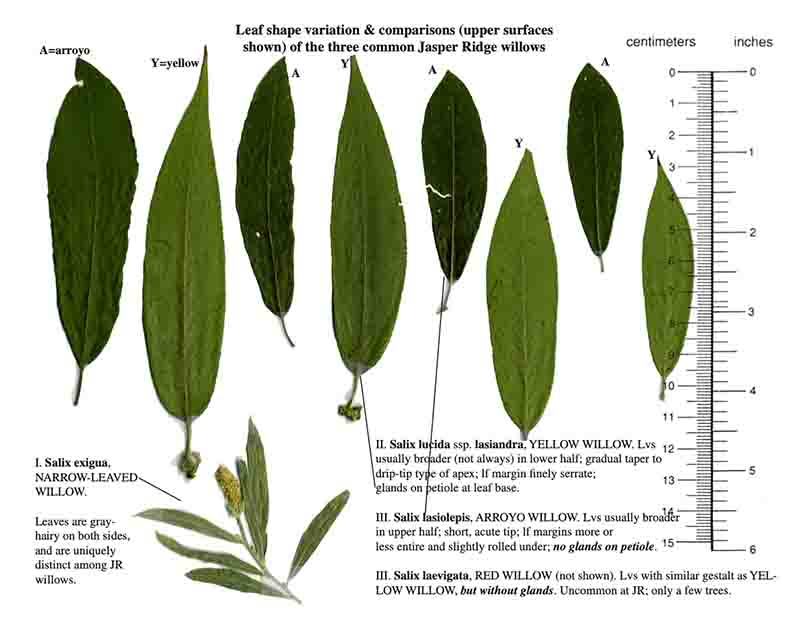Salix exigua var. hindsiana
 Hinds’ willow
S. laevigata
Hinds’ willow
S. laevigata
 red willow
S. lasiandra var. lasiandra
red willow
S. lasiandra var. lasiandra
 Pacific willow, yellow willow
S. lasiolepis
Pacific willow, yellow willow
S. lasiolepis
 arroyo willow
arroyo willow
A good place to see some of the native willows is in the inlet to Lake Lagunita. All the species, except the narrow-leaved willow, have leaves with shiny green upper surfaces and are silvery gray beneath. When the wind blows in the willows the pattern of contrasts is very characteristic. The male trees have catkins composed of numerous tiny staminate flowers which, if examined with a lens, are seen to consist only of the stamens plus the hairy bract from which the stamens emerged. The female trees have similar catkins whose numerous flowers consist only of a pistil plus bract. The fruit is a two-valved capsule with many hairy seeds.
While most willows along the shore of Lake Lagunita are arroyo willow, there is at least one taller red willow. Arroyo willow, Pacific willow, and Hinds’ willow are fairly common at Jasper Ridge, and all can be viewed within a short distance on the Searsville Lake causeway.
- Hinds’ willow (Salix exigua var. hindsiana, syn. S. hindsiana, native range Oregon to Baja California) forms shrubby thickets dense or sparse as well as stands of taller trees in openings of the riparian woodland canopy, south of Searsville Reservoir.
- Red willow (Salix laevigata, native range western North America) is common in the riparian woodland, around the shore of the reservoir, and in the streams below Searsville Dam.
- Pacific willow (Salix lasiandra var. lasiandra, syn. S. lucida subsp. lasiandra, native range Alaska to New Mexico) is typically a tall tree and co-dominant in the riparian woodland with red willow.
- Arroyo willow (Salix lasiolepis, native range western and central US to Mexico) is a shrub or small tree of edges of the riparian woodland and along smaller drainages, where it is the only willow growing. It can also grow into a large tree in the riparian woodland.
On campus, arroyo willow grows on the northern edge of the parking lot in front of Bing Concert Hall. A small thicket is on the left of the front of the driveway at 511 Gerona Road. Along the Stanford Avenue creek, see arroyo willow at the small bridge opposite Mears Court. Further up the creek opposite Penny Nixon School, a stout dark-trunked red willow soars upwards (map pin). A rather sprawling red willow is nearby, at the little dam.
Related material:
Excerpt from Toni Corelli, “Willows found and documented at Jasper Ridge,” JRBP Field Notes, March, 2004. ©Toni Corelli and JRBP.
Although we have five willows in the family Salicaceae (willow family), in the genus Salix, listed in the Vascular Plant List, I have only found four at the Preserve. Three of these are fairly common and one is uncommon at JRBP.
Common features of the willows are: woody plants, shrubs or trees; deciduous, all leaves are lost every year; dioecious (two houses), male and female flowers are on separate plants; flowers lack sepals and petals, but have scale-like bracts (a structure at the base of each flower) and nectar glands associated with each flower; flowers are arranged in catkins, a spikelike inflorescence of many unisexual flowers, usually pendent; fruit is a capsule with many seeds, each seed is covered with fine or cottony hairs and these can be seen floating in the air in late winter through summer. Habitat: moist areas.
Plants with flowers arranged in catkins as in the willows, also our oaks, alders, and others are usually wind pollinated. The stamen shed the pollen and it is blown in the wind to the pistillate flowers. However, the willows have 1–2 nectary glands associated with each flower, which produces nectar that is a reward for visiting insect vectors that can pick up the pollen and deliver it to the other plants it also visits. Either the wind and/or an insect vector can pollinate the willows so it’s not just “The Wind in the Willows.”
Key to willows found at Jasper Ridge Biological Preserve:
1. Leaves narrow and linear, both sides gray silky hairy; stamens 2; ovary without hairs or silky hairy – Salix exigua var. hindsiana (Hinds’ willow)
1’ Leaves not narrow and linear, not gray silky on both sides
2. Bud scale free; stamens 5; ovary without hairs; petiole generally without glands; twigs red to yellow brown – Salix laevigata (red willow)
2’ Bud scales fused
3. Glands on stipules, petiole, base of leaf blade; leaf margins fine toothed, gland-tipped; stamens 3–5; ovary without hairs – Salix lasiandra var. lasiandra (Pacific willow)
3’ Without glands on stipules or petioles; stamens 2; ovary without hairs – Salix lasiolepis (arroyo willow)
Willows not found recently at JRBP but on a historical plant list:
- Sitka willow (Salix sitchensis) – Shrub, small tree; twigs yellowish or reddish brown covered with silky hairs lost with age; upper leaf surface dull green, with a few or many silky hairs that are lost with age, lower blade densely silky hairy; stipules small, or lacking; bud scale margin fused; inflorescence appearing just before or with the leaves; flower bract tawny or brown; stamen 1; ovary silky. Synonym S. coulteri.
References:
- Hickman, J.C. (Editor). (1993). The Jepson Manual: Higher Plants of California.
University of California Press, Berkeley, California.
- West-Bourke, Diane. (1985). Entomophily and anemophily in three sympatric willows: Salix hindsiana, S. lasiandra, and S. lasiolepis. M.A. thesis, Department of Biological Sciences, San Jose State University.
- Villaseñor, J.L. (2016). Checklist of the native vascular plants of Mexico. Revista Mexicana de Biodiversidad 87: 559-902. Indicates Salix hindsiana native to Baja California.
About this Entry: The introductory paragraph is from the book Trees of Stanford and Environs, by Ronald Bracewell, published 2005. John Rawlings added S. exigua and the rest of the material. Scientific and common names updated; descriptions extended; campus locations added (Feb 2024, JR, SP). Stanford Ave locations added (Sep 2024, SP).








